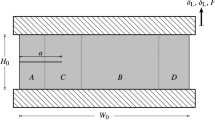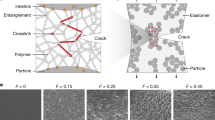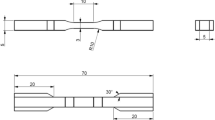Abstract
THE stress–strain relationship of rubber under unidirectional compression with free expansions in the other two directions has been derived from the kinetic theory of rubber-like elasticity by Treloar1 and others. These conditions can be simulated by compressing the rubber between parallel plates at which friction is eliminated by lubrication. The static compressive stress σs (lb./in.2) is given by  where G
s is the static shear modulus and λ the ratio of compressed to initial height. This relationship holds true provided the lubrication is adequate. Where free lateral expansion is prevented by friction or bonding at the confining surfaces, the shape of the rubber influences the stress–strain relationships in a way that has hitherto defied systematic analysis. Kimmich2 showed that most of the difficulty in correlating published results may be explained by the nature of the surface of the compressing plates and of the rubber, the manner of applying the stress, the thixotropic behaviour of some rubbers, and because the stress–strain relationship is not linear. As the industrial uses of rubber in compression (usually with the faces bonded to metal) are very numerous, a mathematical relation between stress and strain is essential for design purposes. It is the purpose of this communication to point out a general relationship obtained from experimental results for rubber specimens of various sizes bonded to metal plates.
where G
s is the static shear modulus and λ the ratio of compressed to initial height. This relationship holds true provided the lubrication is adequate. Where free lateral expansion is prevented by friction or bonding at the confining surfaces, the shape of the rubber influences the stress–strain relationships in a way that has hitherto defied systematic analysis. Kimmich2 showed that most of the difficulty in correlating published results may be explained by the nature of the surface of the compressing plates and of the rubber, the manner of applying the stress, the thixotropic behaviour of some rubbers, and because the stress–strain relationship is not linear. As the industrial uses of rubber in compression (usually with the faces bonded to metal) are very numerous, a mathematical relation between stress and strain is essential for design purposes. It is the purpose of this communication to point out a general relationship obtained from experimental results for rubber specimens of various sizes bonded to metal plates.
This is a preview of subscription content, access via your institution
Access options
Subscribe to this journal
Receive 51 print issues and online access
$199.00 per year
only $3.90 per issue
Buy this article
- Purchase on Springer Link
- Instant access to full article PDF
Prices may be subject to local taxes which are calculated during checkout
Similar content being viewed by others
References
Treloar, L. R. G., “Physics of Rubber Elasticity”, 255 (Clarendon Press, Oxford, 1949).
Kimmich, E. G., India Rubb. World, 103, No. 3, 45 (1940).
Hattori, R., and Takei, K., J. Soc. Rubb. Inst. Japan, 23, 194 (1950).
Schay, G., and Ször, P., Acta Chim. Hung., 2, No. 4, 317 (1952).
De Meij, S., and van Amerongen, G. J., paper read at the Deutsche Kautschuk-Gesellschaft, Munich (October 21–23, 1954).
Author information
Authors and Affiliations
Rights and permissions
About this article
Cite this article
PAYNE, A. Effect of Shape on the Static and Dynamic Stress–Strain Relationship of Bonded Rubber in Compression. Nature 177, 1174–1175 (1956). https://doi.org/10.1038/1771174a0
Issue Date:
DOI: https://doi.org/10.1038/1771174a0
Comments
By submitting a comment you agree to abide by our Terms and Community Guidelines. If you find something abusive or that does not comply with our terms or guidelines please flag it as inappropriate.



